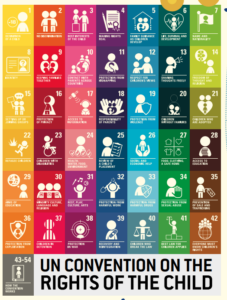Children’s Rights

Rabbie Our Rights Coo at Ballerup

What is it?
In March 2021, the United Nations Convention on the Rights of the Child (UNCRC) Bill became law in Scotland, meaning public bodies need to comply with all aspects of this new law. The national approach to supporting children, “Getting It Right For Every Child,” was built upon the foundation of the UNCRC.
The Scottish Government states,
“We want to recognise, respect and promote children’s rights. These include rights to be treated fairly, to be heard and to be as healthy as possible. Our vision is a Scotland where children’s human rights are embedded in all aspects of society. A Scotland where policy, law and decision making takes account of children’s rights and where all children have a voice and are empowered to be human rights defenders. Parents, local and national governments and organisations which work with children and families can help children experience their rights. We are taking steps to ensure that children enjoy their rights, as set out in the United Nations Convention on the Rights of the Child (UNCRC).”
(Human Rights: Children’s Rights, Scottish Government)
“The Rights of the Child, Relationships, Responsive Care and Respect are the four key principles which form the basis of this guidance. All staff working with babies and young children should be aware that these key principles are interrelated and interdependent.
Within the United Nations Convention on the Rights of the Child (UNCRC) is the principle that children should be valued and respected at all levels and have the right to have their views heard and acted upon. This means that all adults and agencies should ensure when supporting babies and young children that their views are ‘…given due weight in accordance with the age and maturity of the child’ (UN, 1989, Article 12).”
(Pre-birth to Three: Positive Outcomes for Scotland’s Children and Families, Learning and Teaching Scotland, 2010, p. 19)
Key messages:
- An effective children’s rights-based approach should be embedded in a setting’s vision, values and aims, ethos, routines, and when implementing change. It should not be ‘another thing to do’ but already underpin the setting’s pedagogy and be part of practice.
- Children’s rights are unconditional. They must be respected but children do not have a responsibility to uphold the rights of others.
- Practitioners using consistent rights-based language helps children connect their rights, actions, and impact on those around them.
- Practitioners view and believe that children are active, capable and competent learners.
- All practitioners working with children have an essential role in ensuring that children’s rights are modelled, safeguarded, and actively promoted. They follow GIRFEC guidance, respecting, including, and protecting children in their care, valuing their views and ideas.
- Opportunities to include children in planning for change and decision-making are embedded within the practice.
- The setting works closely with parents and other professionals, recognising the vital contribution they have to make.
The United Nations Convention on the Rights of the Child contains 54 articles. The most relevant articles that concern children at Early Level include:
- Article 12 (respect views of the child): Every child has the right to express their views, feelings, and wishes in all matters affecting them and to have their views considered and taken seriously.
- Article 14 (freedom of thought, belief and religion): Every child has the right to think and believe what they choose and practise their religion, as long as they are not stopping other people from enjoying their rights.
- Article 15 (freedom of association): Every child has the right to meet with other children and to join groups and organisations, as long as this does not stop other people from enjoying their rights.
- Article 24 (health and health services): Every child has the right to the best possible health.
- Article 28 (right to an education): Every child has the right to an education.
- Article 31 (leisure, play and culture): Every child has the right to rest, relax, play, and participate in cultural and creative activities.
The UNCRC articles can be read in full here or in the child-friendly version.
Ways we can do this:
Respecting the rights of others: When discussing the rights of a child, it is vital that with every right, a discussion is had about the commitment that individuals have to others to help uphold the rights of everyone. In Article 12, every child has the right to express their views, feelings and opinions. However, they also should listen and respect the views and feelings of others.
Practitioners respond in the moment (responsive planning), using the children’s ideas within the continuous provision and intentional planning.
A democratic approach is developed, where the power balance is evenly spread between adults and children. Children’s opinions direct the organisation of the day, resourcing, and when creating spaces.
Children are respected and listened to; they have an expectation and a right to be included in the decision-making processes around them. This may involve discussing new resources to buy, what is for snack, where and when they want to eat a snack, how and where they choose to spend their time (indoors or outdoors), or trips to places ‘beyond the gates‘.
Practitioners should familiarise themselves with all the UNCRC articles but prioritise those most relevant and meaningful to the setting and children in their care. Consider selecting 2 or 3 articles initially to share with the children; they must be embedded into practice and used consistently by practitioners before introducing further articles.
Practitioners could consider using picture books (see recommended reads in the Tools section) to introduce the rights to the children and then refer to them during play.
Various websites offer illustrated versions of the children’s rights, which can support children learning about their rights. Practitioners should regularly and consistently refer to these illustrated pictures when discussing rights and avoid such images becoming ‘wallpaper’.
Embedding the rights in practice: Children need help to connect their rights and what they look like in their day to day lives. The children’s ideas and opinions should be sought by practitioners to ensure they are genuinely heard. Consulting our Youngest Children (Highland Child Protection Committee, Keeping Children Safe and Care and Learning Alliance, 2021) can be used to support ways to gathering information from the children.
Practitioners can use the knowledge of the rights to reinforce positive behaviour and develop children’s understanding of the consequences of their actions.
Making links between GIRFEC wellbeing indicators and child rights can further help illustrate the importance of everyone’s rights in our day to day lives. Supporting children through conversation and naturally using the language of rights can introduce these ideas in an accessible way.
Article 12 (respect views of the child):
- Everyone has the right to their turn to speak.
- “Thank you for listening so carefully to ‘name of child’, and now it is your turn to speak.” “We listened to you speak *name of child* and now is it respectful for you to listen to ‘name of child’.
- Practitioners to make connections between ‘respect’ and ‘included’.
Article 14 (freedom of thought, belief and religion):
- “Thank you for sharing your ideas. Does anyone else have a different idea? It is ok for us to have different ideas or believe in different things. Being different is was makes us special.”
- Practitioners to make connections between ‘included’ and ‘respect’.
Article 15 (freedom of association):
- Everyone has the right to meet people and make new friends.
- “That was kind of you to invite *name of child* to play because everyone has the right to be friends.”
- “Everyone has the right to be included, so thank you for making sure everyone can play.”
- Practitioners to make connections between ‘active’, ‘respect’ and ‘included’.
Article 24 (health and health services):
- “It is important to keep ourselves healthy by washing our hands and playing safely with our friends.”
- “Do you think that is safe? I wonder what we can do to ensure everyone playing this game is safe.”
- Practitioners to make connections between ‘safe’, ‘responsibility’ and ‘active’.
Article 28 (right to an education):
- Everyone has the right to come to nursery and school to learn new things.
- “The adults are here to help you learn, but we can help our friends learn too.”
- “Lots of children enjoy listening to this story to help them learn, and your *actions* distract them from their learning. I wonder what you could do differently to help them concentrate?”
- Practitioners to make connections between ‘achieving’, ‘respect’, ‘responsibility’ and ‘active’.
Article 31 (leisure, play and culture):
- Everyone has the right to relax and play in the nursery or school.
- “Perhaps you didn’t notice that *name of child* is enjoying her right to some quiet time reading that book. I wonder what you could do differently with that loud fire engine to ensure she has that quiet time?”
- Practitioners to make connections between ‘active’, ‘achieving’ and ‘responsibility’.
For more information see “Learning through rights in the early years- Weaving the UNCRC through Policy, Provision and Everyday Practice” document.
Why children’s rights matter
In this video about the United Nations Convention on the Rights of the Child (UNCRC) features members of Children’s Parliament. They discuss the need for UNCRC incorporation and the impact of making rights real for children in Scotland today.
Creating accessible resources
When creating and sharing resources:
- always make sure that they are written in child-friendly language
- consider if they should also be produced in Gaelic, British Sign Language or other community languages
- expand acronyms, including UNCRC, on slides and when speaking so everyone can understand what they stand for
Read more tips for creating child friendly information (PDF cypcs.org.uk)
How to respect everyone’s rights
We can facilitate and communicate rights through:
- including a regular section on human rights (including the UNCRC) in meetings
- asking for any special requirements participants or visitors have
- ensuring venues are fully accessible
- providing a way for participants to give feedback on how inclusive the session was
- making every effort to enable participants to use their language of choice
- treating people as individuals and avoid making assumptions or projecting cultural stereotypes
- linking the UNCRC articles to any professional learning delivered
- helping every child and young person reach their potential
- giving children and young people meaningful opportunities to participate in decision making
Supporting meaningful participation
Children and young people must have a safe, inclusive space to form ideas, express their views and participate. Visit learner participation in educational settings for more information and resources to support meaningful participation.
The Lundy Model of Participation provides a framework for understanding Article 12 of the UNCRC. It focuses on four related elements. The four elements have a rational chronological order:
- space
- voice
- audience
- influence
Stage one: “children and young people need to feel that they can express their views”.
Stage two: “these views need to be heard and acted upon as appropriate”

